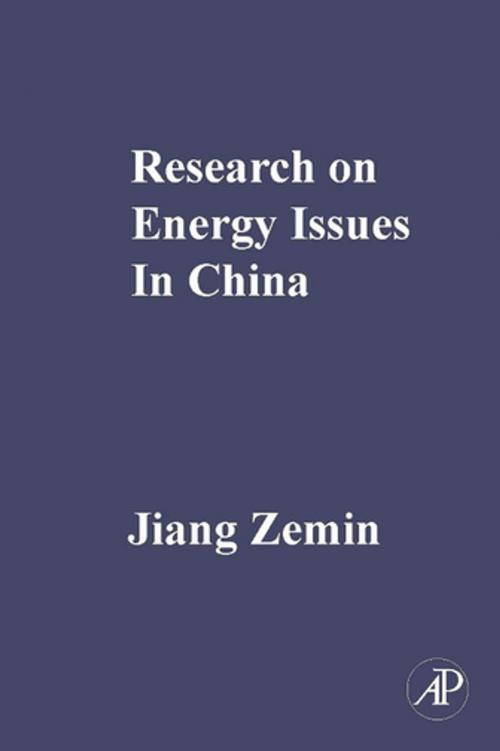Research on Energy Issues in China
Nonfiction, Science & Nature, Technology, Environmental, Business & Finance, Industries & Professions, Industries| Author: | Jiang Zemin | ISBN: | 9780123786203 |
| Publisher: | Elsevier Science | Publication: | August 7, 2009 |
| Imprint: | Academic Press | Language: | English |
| Author: | Jiang Zemin |
| ISBN: | 9780123786203 |
| Publisher: | Elsevier Science |
| Publication: | August 7, 2009 |
| Imprint: | Academic Press |
| Language: | English |
China’s rapid economic expansion raises questions internally and externally about how it will acquire the energy it needs to sustain growth. Currently it is the largest producer and consumer of coal; how much will it continue to rely on its abundant natural resource in the face of increasing environmental concerns? Will it embrace new clean coal technologies developed by others or invest in its own? Currently it imports 50% of the oil it consumes; will it invest in technologies that scrub the ocean floor for petroleum deposits? Will it develop new distribution technologies to bring its natural gas reserves closer to population centers? What role will conservation play? And how will China relate to the rest of the international community as it addresses these critical issues.
Research on Energy Issues In China presents one prominent insider’s view of China’s key energy issues and his strategy for addressing them. A collection of papers authored by Jiang Zemin, former president of the People’s Republic of China, it appears here in English for the first time. Jiang’s message is an exhortation to the Chinese to invest in science and technology, and research and development, to ensure the steady supply of energy so crucial for sustaining and driving development. He outlines this energy strategy for China: "we need to steadfastly conserve energy, use it efficiently, diversify development, keep the environment clean, be technology driven and cooperate internationally in order to establish a system of energy production, distribution and consumption that is highly efficient, uses advanced technology, produces few pollutant, has minimal impact on the ecosystem, and provides a steady and secure energy supply."
Within ten to twenty years, China may well be the world’s largest energy consumption and supply system. This volume offers policy makers, energy industry analysts, researchers, and investors an inside view of how it plans to get there.
- Compares China’s current energy situation with the developed world
- Details specific challenges and opportunities in China with respect to coal, oil, nuclear, natural gas, solar, biomass, hydrogen, geothermal, wind, and ocean
- Presents an eight point energy development policy
- Provides a guide to China’s future investment in research and development
China’s rapid economic expansion raises questions internally and externally about how it will acquire the energy it needs to sustain growth. Currently it is the largest producer and consumer of coal; how much will it continue to rely on its abundant natural resource in the face of increasing environmental concerns? Will it embrace new clean coal technologies developed by others or invest in its own? Currently it imports 50% of the oil it consumes; will it invest in technologies that scrub the ocean floor for petroleum deposits? Will it develop new distribution technologies to bring its natural gas reserves closer to population centers? What role will conservation play? And how will China relate to the rest of the international community as it addresses these critical issues.
Research on Energy Issues In China presents one prominent insider’s view of China’s key energy issues and his strategy for addressing them. A collection of papers authored by Jiang Zemin, former president of the People’s Republic of China, it appears here in English for the first time. Jiang’s message is an exhortation to the Chinese to invest in science and technology, and research and development, to ensure the steady supply of energy so crucial for sustaining and driving development. He outlines this energy strategy for China: "we need to steadfastly conserve energy, use it efficiently, diversify development, keep the environment clean, be technology driven and cooperate internationally in order to establish a system of energy production, distribution and consumption that is highly efficient, uses advanced technology, produces few pollutant, has minimal impact on the ecosystem, and provides a steady and secure energy supply."
Within ten to twenty years, China may well be the world’s largest energy consumption and supply system. This volume offers policy makers, energy industry analysts, researchers, and investors an inside view of how it plans to get there.
- Compares China’s current energy situation with the developed world
- Details specific challenges and opportunities in China with respect to coal, oil, nuclear, natural gas, solar, biomass, hydrogen, geothermal, wind, and ocean
- Presents an eight point energy development policy
- Provides a guide to China’s future investment in research and development















